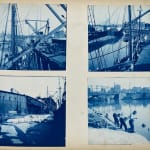William Oechsler
Cyanotype Views of Ohio, 1900s
Photo album; cyanotypes (208)
Each 3 1/2 x 3/12 inches
With photographer's credit stamp to some album pages.
With photographer's credit stamp to some album pages.
Sold
A fascinating album showing life and industry in Toledo, Ohio, this album was created by a talented amateur photographer named William V. Oechsler (1863-1935), the Ohio-born son of German immigrants...
A fascinating album showing life and industry in Toledo, Ohio, this album was created by a talented amateur photographer named William V. Oechsler (1863-1935), the Ohio-born son of German immigrants who worked as a bookkeeper for the S.C. Schenck Company -- a large coal wholesaler with docks in Toledo and Chicago.
The album includes some images of presumed family and friends, but much of it is devoted to shots of the operations of the Schenck Company and other commercial activity along Toledo's many rail lines and waterways. There are images of the S.C. Schenck warehouse, its delivery wagons, piles of coal in a lot, and coal being moved in buckets to or from rail cars via a pulley system on a dock. There are many other interesting shots of dock equipment and machinery, locomotives, shipping cars, and boats of different types and sizes. In the late 19th century, "Toledo’s transformation to an industrial center was moving forward rapidly. Fueled by its status as a great railroad center—Toledo was second only to Chicago in the number of railroads entering the city—a number of local industries began to emerge, including carriage makers, furniture crafters, wheel makers, breweries, foundries, and medical device manufacturers" (Toledo.com). Some of these industries are visible in the album, including the massive building and one of the wagons of the Toledo Brewing and Malting Company, which was in business from 1882 to 1902.
There are also images of workers. several that include an apparently beloved dog, several of a woman (Mrs. Oeschsler?) with a rifle or a bicycle, and four beautifully-printed photograms of plant-life, which appear on the album’s front cover.
The album includes some images of presumed family and friends, but much of it is devoted to shots of the operations of the Schenck Company and other commercial activity along Toledo's many rail lines and waterways. There are images of the S.C. Schenck warehouse, its delivery wagons, piles of coal in a lot, and coal being moved in buckets to or from rail cars via a pulley system on a dock. There are many other interesting shots of dock equipment and machinery, locomotives, shipping cars, and boats of different types and sizes. In the late 19th century, "Toledo’s transformation to an industrial center was moving forward rapidly. Fueled by its status as a great railroad center—Toledo was second only to Chicago in the number of railroads entering the city—a number of local industries began to emerge, including carriage makers, furniture crafters, wheel makers, breweries, foundries, and medical device manufacturers" (Toledo.com). Some of these industries are visible in the album, including the massive building and one of the wagons of the Toledo Brewing and Malting Company, which was in business from 1882 to 1902.
There are also images of workers. several that include an apparently beloved dog, several of a woman (Mrs. Oeschsler?) with a rifle or a bicycle, and four beautifully-printed photograms of plant-life, which appear on the album’s front cover.



